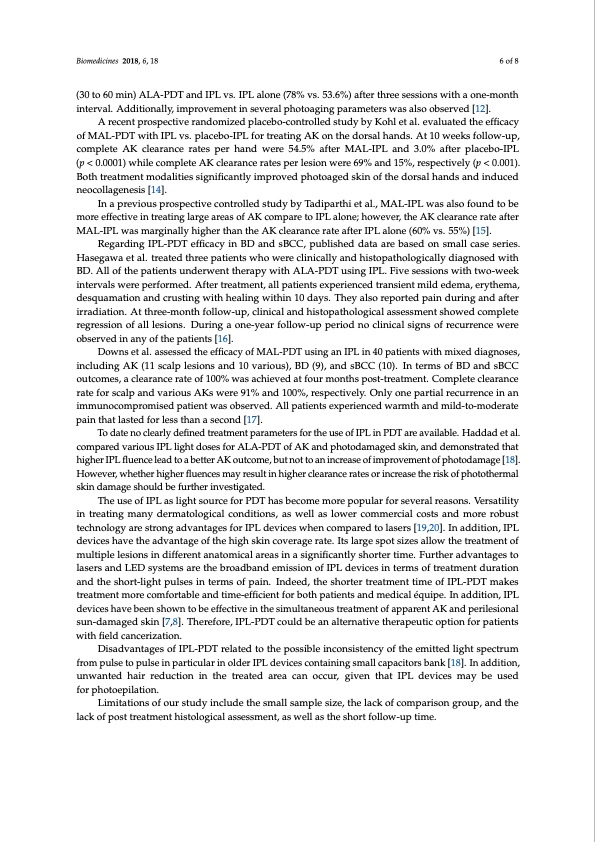
PDF Publication Title:
Text from PDF Page: 006
Biomedicines 2018, 6, 18 6 of 8 (30 to 60 min) ALA-PDT and IPL vs. IPL alone (78% vs. 53.6%) after three sessions with a one-month interval. Additionally, improvement in several photoaging parameters was also observed [12]. A recent prospective randomized placebo-controlled study by Kohl et al. evaluated the efficacy of MAL-PDT with IPL vs. placebo-IPL for treating AK on the dorsal hands. At 10 weeks follow-up, complete AK clearance rates per hand were 54.5% after MAL-IPL and 3.0% after placebo-IPL (p < 0.0001) while complete AK clearance rates per lesion were 69% and 15%, respectively (p < 0.001). Both treatment modalities significantly improved photoaged skin of the dorsal hands and induced neocollagenesis [14]. In a previous prospective controlled study by Tadiparthi et al., MAL-IPL was also found to be more effective in treating large areas of AK compare to IPL alone; however, the AK clearance rate after MAL-IPL was marginally higher than the AK clearance rate after IPL alone (60% vs. 55%) [15]. Regarding IPL-PDT efficacy in BD and sBCC, published data are based on small case series. Hasegawa et al. treated three patients who were clinically and histopathologically diagnosed with BD. All of the patients underwent therapy with ALA-PDT using IPL. Five sessions with two-week intervals were performed. After treatment, all patients experienced transient mild edema, erythema, desquamation and crusting with healing within 10 days. They also reported pain during and after irradiation. At three-month follow-up, clinical and histopathological assessment showed complete regression of all lesions. During a one-year follow-up period no clinical signs of recurrence were observed in any of the patients [16]. Downs et al. assessed the efficacy of MAL-PDT using an IPL in 40 patients with mixed diagnoses, including AK (11 scalp lesions and 10 various), BD (9), and sBCC (10). In terms of BD and sBCC outcomes, a clearance rate of 100% was achieved at four months post-treatment. Complete clearance rate for scalp and various AKs were 91% and 100%, respectively. Only one partial recurrence in an immunocompromised patient was observed. All patients experienced warmth and mild-to-moderate pain that lasted for less than a second [17]. To date no clearly defined treatment parameters for the use of IPL in PDT are available. Haddad et al. compared various IPL light doses for ALA-PDT of AK and photodamaged skin, and demonstrated that higher IPL fluence lead to a better AK outcome, but not to an increase of improvement of photodamage [18]. However, whether higher fluences may result in higher clearance rates or increase the risk of photothermal skin damage should be further investigated. The use of IPL as light source for PDT has become more popular for several reasons. Versatility in treating many dermatological conditions, as well as lower commercial costs and more robust technology are strong advantages for IPL devices when compared to lasers [19,20]. In addition, IPL devices have the advantage of the high skin coverage rate. Its large spot sizes allow the treatment of multiple lesions in different anatomical areas in a significantly shorter time. Further advantages to lasers and LED systems are the broadband emission of IPL devices in terms of treatment duration and the short-light pulses in terms of pain. Indeed, the shorter treatment time of IPL-PDT makes treatment more comfortable and time-efficient for both patients and medical équipe. In addition, IPL devices have been shown to be effective in the simultaneous treatment of apparent AK and perilesional sun-damaged skin [7,8]. Therefore, IPL-PDT could be an alternative therapeutic option for patients with field cancerization. Disadvantages of IPL-PDT related to the possible inconsistency of the emitted light spectrum from pulse to pulse in particular in older IPL devices containing small capacitors bank [18]. In addition, unwanted hair reduction in the treated area can occur, given that IPL devices may be used for photoepilation. Limitations of our study include the small sample size, the lack of comparison group, and the lack of post treatment histological assessment, as well as the short follow-up time.PDF Image | Photodynamic Therapy Pulsed Light Treatment of Nonmelanoma

PDF Search Title:
Photodynamic Therapy Pulsed Light Treatment of NonmelanomaOriginal File Name Searched:
biomedicines-06-00018.pdfDIY PDF Search: Google It | Yahoo | Bing
Cruise Ship Reviews | Luxury Resort | Jet | Yacht | and Travel Tech More Info
Cruising Review Topics and Articles More Info
Software based on Filemaker for the travel industry More Info
The Burgenstock Resort: Reviews on CruisingReview website... More Info
Resort Reviews: World Class resorts... More Info
The Riffelalp Resort: Reviews on CruisingReview website... More Info
| CONTACT TEL: 608-238-6001 Email: greg@cruisingreview.com | RSS | AMP |